中西方龙文化差异对比研究
- 格式:docx
- 大小:49.70 KB
- 文档页数:18
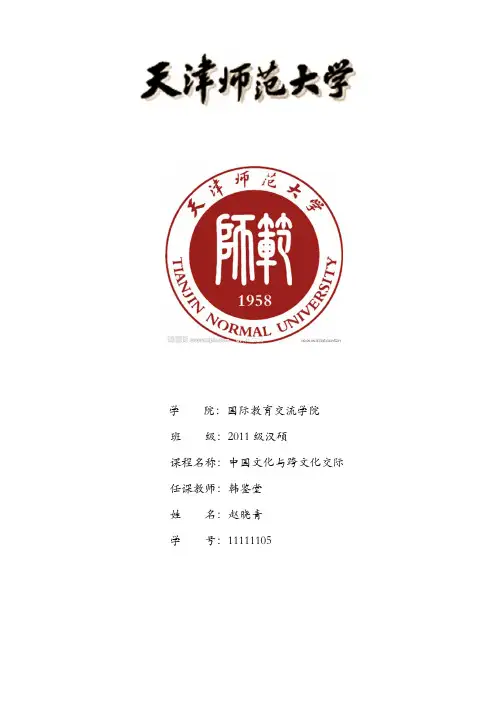
学院:国际教育交流学院班级:2011级汉硕课程名称:中国文化与跨文化交际任课教师:韩鉴堂姓名:赵晓青学号:11111105中国文化,博大精深,在众多具有代表中华精神意义的事物中,龙的地位尤为彰显。
中国人敬龙,爱龙,把龙奉为图腾,在许多事物上将龙作为装饰,用来表示福祉。
中国有数千年的龙文化,海内外数亿中国同胞称自己为“龙的传人”,将中国文化称为“龙的文化”。
九州大地上,“龙”已经渗透到中国社会的各个方面,称为中国文化的凝聚和沉积,龙成了中华民族的象征,中国文化的象征。
对每一个炎黄子孙来说,“龙的传人”无疑是一种特殊的符号,并且为每个人喜欢,随着世界越来越小,对龙的这样的特殊感情传播到世界各地,在世界各国的华人居住区内,龙是最多并最引起注目的饰物,因而,“龙的传人”,“龙的国度”也得到了世界的认可。
随着全球化进程的推进,人类已经进入了多元文化并存的时代,跨文化交际的地位越来越重要。
未来促进跨文化交际,人们开始对中西方龙文化进行比对,很多人都认为而这之间有很大的差异,虽然它们都是没有考证的传说之物,体积庞大,都能飞翔,能力无边,都是想象中充满传奇色彩的动物,又都在文化中长久的保存下来。
但事实上,中国的龙和西方的dragon是两种完全不同的动物。
Dragon一词与龙的对译正如phoenix与凤凰的强行对译,这样的强行对译对中国文化的理解造成了一定的障碍,所以,笔者试图从中西方文化中dragon和龙的不同起源和发展背景,探索它们在不同文化中的象征和意义。
一、中国龙一)龙的形象关于龙的形象,在中国历史上有很多不同的解释。
《说文》曰:“龙,鳞虫之长,能幽能明,能大能小,能长能短,春分而登天,秋分而入川。
”《广雅》云:“有鳞曰蛟龙,有翼曰应龙,有角曰虬龙,无角月螭(chi)龙。
”宋人罗愿的《尔雅翼·释龙》:“角似鹿、头似驼。
眼似兔、项似蛇、腹似蜃、鳞似鱼、爪似鹰、掌似虎、耳似牛。
”《辞海》解释“龙”为古代传说中的一种有鳞有须,能兴云作雨的神异动物。
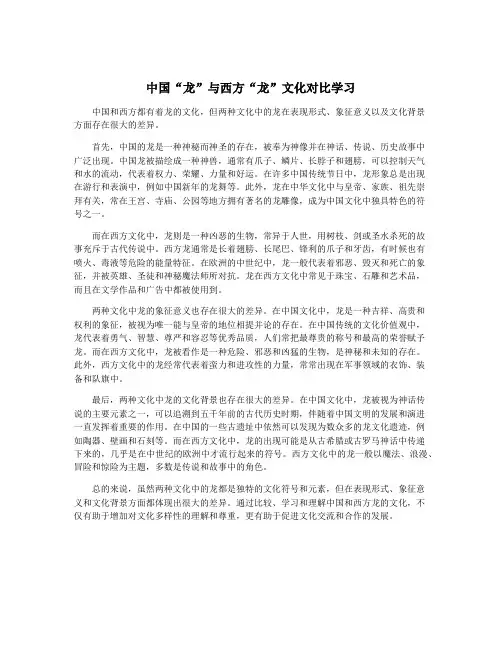
中国“龙”与西方“龙”文化对比学习中国和西方都有着龙的文化,但两种文化中的龙在表现形式、象征意义以及文化背景方面存在很大的差异。
首先,中国的龙是一种神秘而神圣的存在,被奉为神像并在神话、传说、历史故事中广泛出现。
中国龙被描绘成一种神兽,通常有爪子、鳞片、长脖子和翅膀,可以控制天气和水的流动,代表着权力、荣耀、力量和好运。
在许多中国传统节日中,龙形象总是出现在游行和表演中,例如中国新年的龙舞等。
此外,龙在中华文化中与皇帝、家族、祖先崇拜有关,常在王宫、寺庙、公园等地方拥有著名的龙雕像,成为中国文化中独具特色的符号之一。
而在西方文化中,龙则是一种凶恶的生物,常异于人世,用树枝、剑或圣水杀死的故事充斥于古代传说中。
西方龙通常是长着翅膀、长尾巴、锋利的爪子和牙齿,有时候也有喷火、毒液等危险的能量特征。
在欧洲的中世纪中,龙一般代表着邪恶、毁灭和死亡的象征,并被英雄、圣徒和神秘魔法师所对抗。
龙在西方文化中常见于珠宝、石雕和艺术品,而且在文学作品和广告中都被使用到。
两种文化中龙的象征意义也存在很大的差异。
在中国文化中,龙是一种吉祥、高贵和权利的象征,被视为唯一能与皇帝的地位相提并论的存在。
在中国传统的文化价值观中,龙代表着勇气、智慧、尊严和容忍等优秀品质,人们常把最尊贵的称号和最高的荣誉赋予龙。
而在西方文化中,龙被看作是一种危险、邪恶和凶猛的生物,是神秘和未知的存在。
此外,西方文化中的龙经常代表着蛮力和进攻性的力量,常常出现在军事领域的衣饰、装备和队旗中。
最后,两种文化中龙的文化背景也存在很大的差异。
在中国文化中,龙被视为神话传说的主要元素之一,可以追溯到五千年前的古代历史时期,伴随着中国文明的发展和演进一直发挥着重要的作用。
在中国的一些古遗址中依然可以发现为数众多的龙文化遗迹,例如陶器、壁画和石刻等。
而在西方文化中,龙的出现可能是从古希腊或古罗马神话中传递下来的,几乎是在中世纪的欧洲中才流行起来的符号。
西方文化中的龙一般以魔法、浪漫、冒险和惊险为主题,多数是传说和故事中的角色。
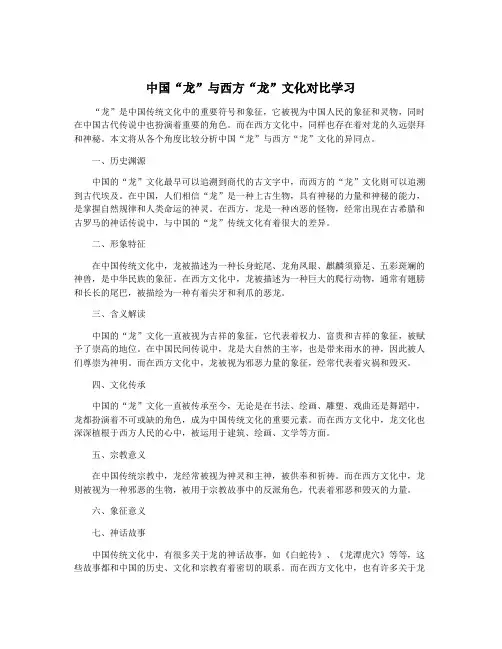
中国“龙”与西方“龙”文化对比学习“龙”是中国传统文化中的重要符号和象征,它被视为中国人民的象征和灵物,同时在中国古代传说中也扮演着重要的角色。
而在西方文化中,同样也存在着对龙的久远崇拜和神秘。
本文将从各个角度比较分析中国“龙”与西方“龙”文化的异同点。
一、历史渊源中国的“龙”文化最早可以追溯到商代的古文字中,而西方的“龙”文化则可以追溯到古代埃及。
在中国,人们相信“龙”是一种上古生物,具有神秘的力量和神秘的能力,是掌握自然规律和人类命运的神灵。
在西方,龙是一种凶恶的怪物,经常出现在古希腊和古罗马的神话传说中,与中国的“龙”传统文化有着很大的差异。
二、形象特征在中国传统文化中,龙被描述为一种长身蛇尾、龙角凤眼、麒麟须獐足、五彩斑斓的神兽,是中华民族的象征。
在西方文化中,龙被描述为一种巨大的爬行动物,通常有翅膀和长长的尾巴,被描绘为一种有着尖牙和利爪的恶龙。
三、含义解读中国的“龙”文化一直被视为吉祥的象征,它代表着权力、富贵和吉祥的象征,被赋予了崇高的地位。
在中国民间传说中,龙是大自然的主宰,也是带来雨水的神,因此被人们尊崇为神明。
而在西方文化中,龙被视为邪恶力量的象征,经常代表着灾祸和毁灭。
四、文化传承中国的“龙”文化一直被传承至今,无论是在书法、绘画、雕塑、戏曲还是舞蹈中,龙都扮演着不可或缺的角色,成为中国传统文化的重要元素。
而在西方文化中,龙文化也深深植根于西方人民的心中,被运用于建筑、绘画、文学等方面。
五、宗教意义在中国传统宗教中,龙经常被视为神灵和主神,被供奉和祈祷。
而在西方文化中,龙则被视为一种邪恶的生物,被用于宗教故事中的反派角色,代表着邪恶和毁灭的力量。
六、象征意义七、神话故事中国传统文化中,有很多关于龙的神话故事,如《白蛇传》、《龙潭虎穴》等等,这些故事都和中国的历史、文化和宗教有着密切的联系。
而在西方文化中,也有许多关于龙的神话故事,如《圣乔治与龙》、《贝奥武夫》等,这些故事都讲述了西方人民对于龙的神秘崇拜和传说。
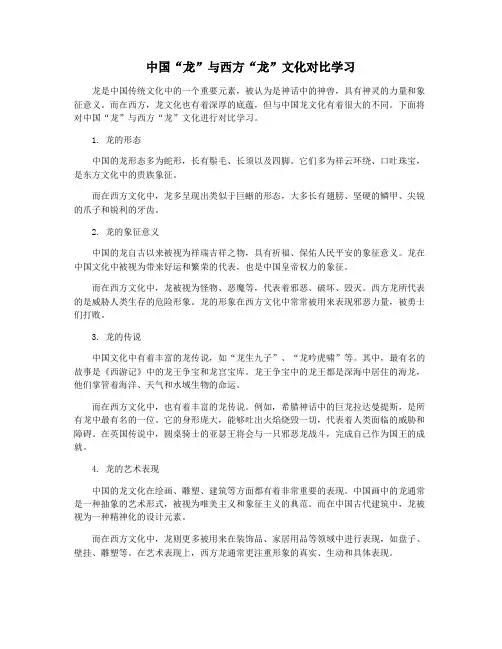
中国“龙”与西方“龙”文化对比学习龙是中国传统文化中的一个重要元素,被认为是神话中的神兽,具有神灵的力量和象征意义。
而在西方,龙文化也有着深厚的底蕴,但与中国龙文化有着很大的不同。
下面将对中国“龙”与西方“龙”文化进行对比学习。
1. 龙的形态中国的龙形态多为蛇形,长有鬃毛、长须以及四脚。
它们多为祥云环绕、口吐珠宝,是东方文化中的贵族象征。
而在西方文化中,龙多呈现出类似于巨蜥的形态,大多长有翅膀、坚硬的鳞甲、尖锐的爪子和锐利的牙齿。
2. 龙的象征意义中国的龙自古以来被视为祥瑞吉祥之物,具有祈福、保佑人民平安的象征意义。
龙在中国文化中被视为带来好运和繁荣的代表,也是中国皇帝权力的象征。
而在西方文化中,龙被视为怪物、恶魔等,代表着邪恶、破坏、毁灭。
西方龙所代表的是威胁人类生存的危险形象。
龙的形象在西方文化中常常被用来表现邪恶力量,被勇士们打败。
3. 龙的传说中国文化中有着丰富的龙传说,如“龙生九子”、“龙吟虎啸”等。
其中,最有名的故事是《西游记》中的龙王争宝和龙宫宝库。
龙王争宝中的龙王都是深海中居住的海龙,他们掌管着海洋、天气和水域生物的命运。
而在西方文化中,也有着丰富的龙传说。
例如,希腊神话中的巨龙拉达曼提斯,是所有龙中最有名的一位。
它的身形庞大,能够吐出火焰烧毁一切,代表着人类面临的威胁和障碍。
在英国传说中,圆桌骑士的亚瑟王将会与一只邪恶龙战斗,完成自己作为国王的成就。
4. 龙的艺术表现中国的龙文化在绘画、雕塑、建筑等方面都有着非常重要的表现。
中国画中的龙通常是一种抽象的艺术形式,被视为唯美主义和象征主义的典范。
而在中国古代建筑中,龙被视为一种精神化的设计元素。
而在西方文化中,龙则更多被用来在装饰品、家居用品等领域中进行表现,如盘子、壁挂、雕塑等。
在艺术表现上,西方龙通常更注重形象的真实、生动和具体表现。
总体而言,中国“龙”与西方“龙”在形态、象征意义、传说以及艺术表现方面都有着很大的区别和差异。
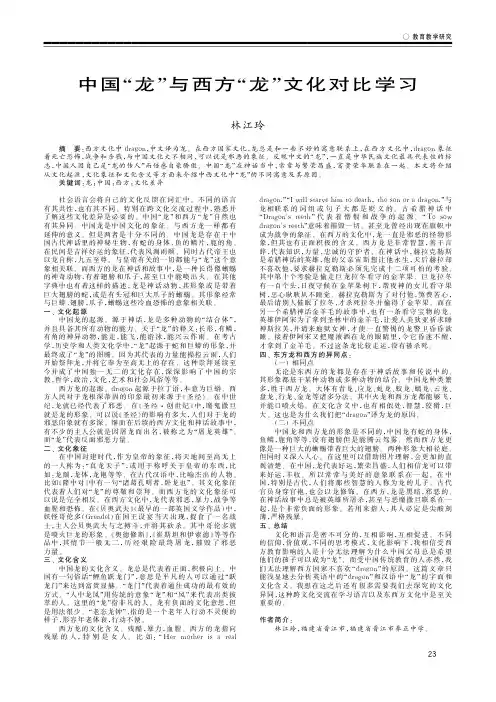
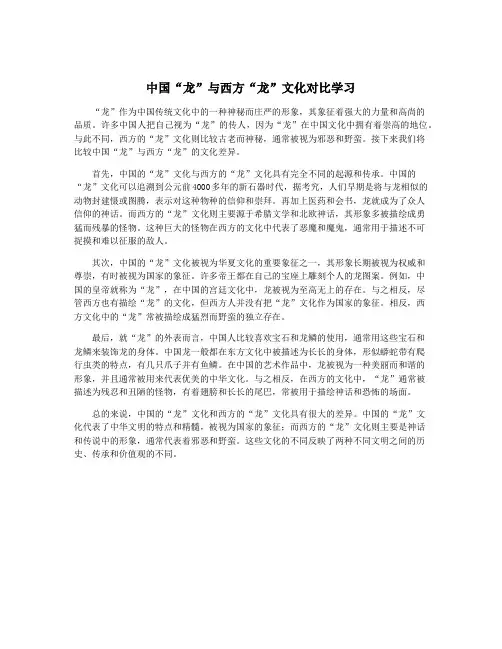
中国“龙”与西方“龙”文化对比学习“龙”作为中国传统文化中的一种神秘而庄严的形象,其象征着强大的力量和高尚的品质。
许多中国人把自己视为“龙”的传人,因为“龙”在中国文化中拥有着崇高的地位。
与此不同,西方的“龙”文化则比较古老而神秘,通常被视为邪恶和野蛮。
接下来我们将比较中国“龙”与西方“龙”的文化差异。
首先,中国的“龙”文化与西方的“龙”文化具有完全不同的起源和传承。
中国的“龙”文化可以追溯到公元前4000多年的新石器时代,据考究,人们早期是将与龙相似的动物封建慑或图腾,表示对这种物种的信仰和崇拜。
再加上医药和会书,龙就成为了众人信仰的神话。
而西方的“龙”文化则主要源于希腊文学和北欧神话,其形象多被描绘成勇猛而残暴的怪物。
这种巨大的怪物在西方的文化中代表了恶魔和魔鬼,通常用于描述不可捉摸和难以征服的敌人。
其次,中国的“龙”文化被视为华夏文化的重要象征之一,其形象长期被视为权威和尊崇,有时被视为国家的象征。
许多帝王都在自己的宝座上雕刻个人的龙图案。
例如,中国的皇帝就称为“龙”,在中国的宫廷文化中,龙被视为至高无上的存在。
与之相反,尽管西方也有描绘“龙”的文化,但西方人并没有把“龙”文化作为国家的象征。
相反,西方文化中的“龙”常被描绘成猛烈而野蛮的独立存在。
最后,就“龙”的外表而言,中国人比较喜欢宝石和龙鳞的使用,通常用这些宝石和龙鳞来装饰龙的身体。
中国龙一般都在东方文化中被描述为长长的身体,形似蟒蛇带有爬行虫类的特点,有几只爪子并有鱼鳞。
在中国的艺术作品中,龙被视为一种美丽而和谐的形象,并且通常被用来代表优美的中华文化。
与之相反,在西方的文化中,“龙”通常被描述为残忍和丑陋的怪物,有着翅膀和长长的尾巴,常被用于描绘神话和恐怖的场面。
总的来说,中国的“龙”文化和西方的“龙”文化具有很大的差异。
中国的“龙”文化代表了中华文明的特点和精髓,被视为国家的象征;而西方的“龙”文化则主要是神话和传说中的形象,通常代表着邪恶和野蛮。

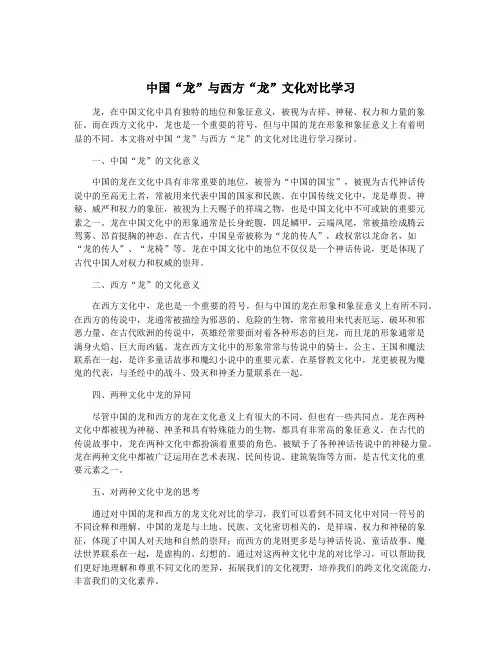
中国“龙”与西方“龙”文化对比学习龙,在中国文化中具有独特的地位和象征意义,被视为吉祥、神秘、权力和力量的象征。
而在西方文化中,龙也是一个重要的符号,但与中国的龙在形象和象征意义上有着明显的不同。
本文将对中国“龙”与西方“龙”的文化对比进行学习探讨。
一、中国“龙”的文化意义中国的龙在文化中具有非常重要的地位,被誉为“中国的国宝”,被视为古代神话传说中的至高无上者,常被用来代表中国的国家和民族。
在中国传统文化中,龙是尊贵、神秘、威严和权力的象征,被视为上天赐予的祥瑞之物,也是中国文化中不可或缺的重要元素之一。
龙在中国文化中的形象通常是长身蛇腹,四足鳞甲,云端凤尾,常被描绘成腾云驾雾、昂首挺胸的神态。
在古代,中国皇帝被称为“龙的传人”,政权常以龙命名,如“龙的传人”、“龙椅”等。
龙在中国文化中的地位不仅仅是一个神话传说,更是体现了古代中国人对权力和权威的崇拜。
二、西方“龙”的文化意义在西方文化中,龙也是一个重要的符号,但与中国的龙在形象和象征意义上有所不同。
在西方的传说中,龙通常被描绘为邪恶的、危险的生物,常常被用来代表厄运、破坏和邪恶力量。
在古代欧洲的传说中,英雄经常要面对着各种形态的巨龙,而且龙的形象通常是满身火焰、巨大而凶猛。
龙在西方文化中的形象常常与传说中的骑士、公主、王国和魔法联系在一起,是许多童话故事和魔幻小说中的重要元素。
在基督教文化中,龙更被视为魔鬼的代表,与圣经中的战斗、毁灭和神圣力量联系在一起。
四、两种文化中龙的异同尽管中国的龙和西方的龙在文化意义上有很大的不同,但也有一些共同点。
龙在两种文化中都被视为神秘、神圣和具有特殊能力的生物,都具有非常高的象征意义。
在古代的传说故事中,龙在两种文化中都扮演着重要的角色,被赋予了各种神话传说中的神秘力量。
龙在两种文化中都被广泛运用在艺术表现、民间传说、建筑装饰等方面,是古代文化的重要元素之一。
五、对两种文化中龙的思考通过对中国的龙和西方的龙文化对比的学习,我们可以看到不同文化中对同一符号的不同诠释和理解。
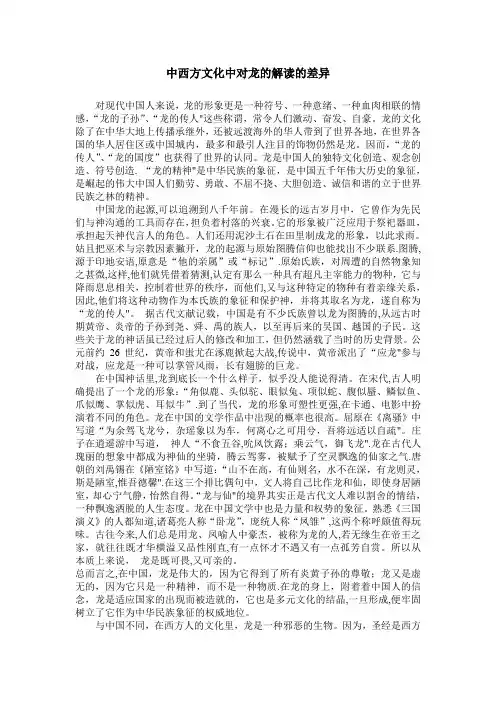
中西方文化中对龙的解读的差异对现代中国人来说,龙的形象更是一种符号、一种意绪、一种血肉相联的情感,“龙的子孙”、“龙的传人"这些称谓,常令人们激动、奋发、自豪。
龙的文化除了在中华大地上传播承继外,还被远渡海外的华人带到了世界各地,在世界各国的华人居住区或中国城内,最多和最引人注目的饰物仍然是龙。
因而,“龙的传人”、“龙的国度”也获得了世界的认同。
龙是中国人的独特文化创造、观念创造、符号创造. “龙的精神"是中华民族的象征,是中国五千年伟大历史的象征,是崛起的伟大中国人们勤劳、勇敢、不屈不挠、大胆创造、诚信和谐的立于世界民族之林的精神。
中国龙的起源,可以追溯到八千年前。
在漫长的远古岁月中,它曾作为先民们与神沟通的工具而存在,担负着村落的兴衰。
它的形象被广泛应用于祭祀器皿,承担起天神代言人的角色。
人们还用泥沙土石在田里制成龙的形象,以此求雨。
姑且把巫术与宗教因素撇开,龙的起源与原始图腾信仰也能找出不少联系.图腾,源于印地安语,原意是“他的亲属”或“标记”.原始氏族,对周遭的自然物象知之甚微,这样,他们就凭借着猜测,认定有那么一种具有超凡主宰能力的物种,它与降雨息息相关,控制着世界的秩序,而他们,又与这种特定的物种有着亲缘关系,因此,他们将这种动物作为本氏族的象征和保护神,并将其取名为龙,遂自称为“龙的传人"。
据古代文献记载,中国是有不少氏族曾以龙为图腾的,从远古时期黄帝、炎帝的子孙到尧、舜、禹的族人,以至再后来的吴国、越国的子民。
这些关于龙的神话虽已经过后人的修改和加工,但仍然涵载了当时的历史背景。
公元前约26世纪,黄帝和蚩尤在涿鹿掀起大战,传说中,黄帝派出了“应龙"参与对战,应龙是一种可以掌管风雨,长有翅膀的巨龙。
在中国神话里,龙到底长一个什么样子,似乎没人能说得清。
在宋代,古人明确提出了一个龙的形象:“角似鹿、头似驼、眼似兔、项似蛇、腹似蜃、鳞似鱼、爪似鹰、掌似虎、耳似牛”.到了当代,龙的形象可塑性更强,在卡通、电影中扮演着不同的角色。
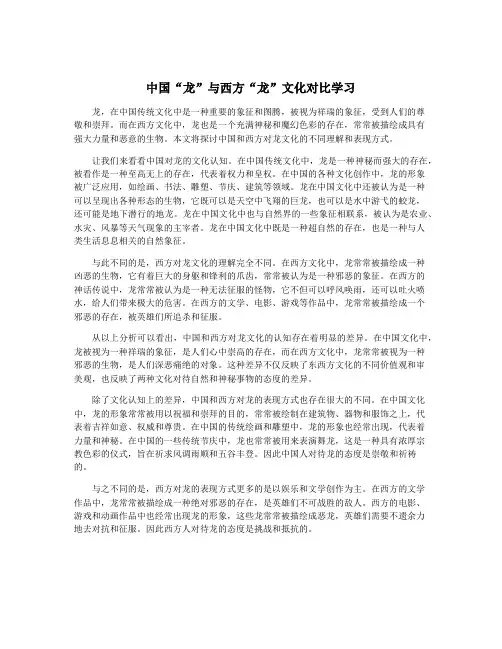
中国“龙”与西方“龙”文化对比学习龙,在中国传统文化中是一种重要的象征和图腾,被视为祥瑞的象征,受到人们的尊敬和崇拜。
而在西方文化中,龙也是一个充满神秘和魔幻色彩的存在,常常被描绘成具有强大力量和恶意的生物。
本文将探讨中国和西方对龙文化的不同理解和表现方式。
让我们来看看中国对龙的文化认知。
在中国传统文化中,龙是一种神秘而强大的存在,被看作是一种至高无上的存在,代表着权力和皇权。
在中国的各种文化创作中,龙的形象被广泛应用,如绘画、书法、雕塑、节庆、建筑等领域。
龙在中国文化中还被认为是一种可以呈现出各种形态的生物,它既可以是天空中飞翔的巨龙,也可以是水中游弋的蛟龙,还可能是地下潜行的地龙。
龙在中国文化中也与自然界的一些象征相联系,被认为是农业、水灾、风暴等天气现象的主宰者。
龙在中国文化中既是一种超自然的存在,也是一种与人类生活息息相关的自然象征。
与此不同的是,西方对龙文化的理解完全不同。
在西方文化中,龙常常被描绘成一种凶恶的生物,它有着巨大的身躯和锋利的爪齿,常常被认为是一种邪恶的象征。
在西方的神话传说中,龙常常被认为是一种无法征服的怪物,它不但可以呼风唤雨,还可以吐火喷水,给人们带来极大的危害。
在西方的文学、电影、游戏等作品中,龙常常被描绘成一个邪恶的存在,被英雄们所追杀和征服。
从以上分析可以看出,中国和西方对龙文化的认知存在着明显的差异。
在中国文化中,龙被视为一种祥瑞的象征,是人们心中崇高的存在,而在西方文化中,龙常常被视为一种邪恶的生物,是人们深恶痛绝的对象。
这种差异不仅反映了东西方文化的不同价值观和审美观,也反映了两种文化对待自然和神秘事物的态度的差异。
除了文化认知上的差异,中国和西方对龙的表现方式也存在很大的不同。
在中国文化中,龙的形象常常被用以祝福和崇拜的目的,常常被绘制在建筑物、器物和服饰之上,代表着吉祥如意、权威和尊贵。
在中国的传统绘画和雕塑中,龙的形象也经常出现,代表着力量和神秘。
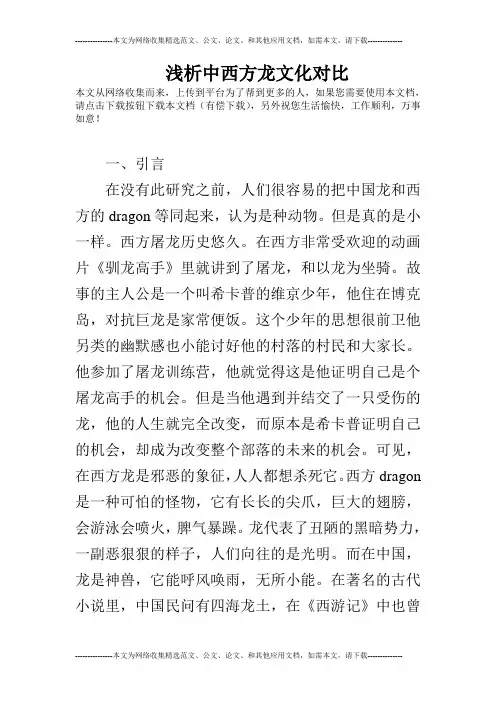
浅析中西方龙文化对比本文从网络收集而来,上传到平台为了帮到更多的人,如果您需要使用本文档,请点击下载按钮下载本文档(有偿下载),另外祝您生活愉快,工作顺利,万事如意!一、引言在没有此研究之前,人们很容易的把中国龙和西方的dragon等同起来,认为是种动物。
但是真的是小一样。
西方屠龙历史悠久。
在西方非常受欢迎的动画片《驯龙高手》里就讲到了屠龙,和以龙为坐骑。
故事的主人公是一个叫希卡普的维京少年,他住在博克岛,对抗巨龙是家常便饭。
这个少年的思想很前卫他另类的幽默感也小能讨好他的村落的村民和大家长。
他参加了屠龙训练营,他就觉得这是他证明自己是个屠龙高手的机会。
但是当他遇到并结交了一只受伤的龙,他的人生就完全改变,而原本是希卡普证明自己的机会,却成为改变整个部落的未来的机会。
可见,在西方龙是邪恶的象征,人人都想杀死它。
西方dragon 是一种可怕的怪物,它有长长的尖爪,巨大的翅膀,会游泳会喷火,脾气暴躁。
龙代表了丑陋的黑暗势力,一副恶狠狠的样子,人们向往的是光明。
而在中国,龙是神兽,它能呼风唤雨,无所小能。
在著名的古代小说里,中国民问有四海龙土,在《西游记》中也曾经提过。
即东海龙土、南海龙土、西海龙土、北海龙土。
它能上天入海,能管降雨,为干涸的土地带来雨水。
它是权威的神圣的象征,在古代皇帝被称为真龙天子。
只有皇帝才能使用带有龙图腾的东西,百姓用是要杀头的。
而龙的矫健,高高在天,是人们膜拜的对象。
它有神力,给人们带来吉祥和安宁。
在中西方文化里面,我们简单的把中国龙和西方dragon对等起来是小可取的,会让人们产生文化上的误会。
事实上,中国龙和西方dragon并小是同一种龙。
中国龙是美好的为人们带来祥和的吉祥神物。
而西方dragon却是丑陋黑暗势力的化身,它能飞越万里,能喷火,咬死人类。
人们希望战胜它,差异巨大。
西方龙有很多种类,有黑龙耐萨里奥,红龙阿莱克斯塔萨,绿龙伊瑟拉,黄龙诺兹多姆。
它西方传说中的一种动物,是邪恶的使者。
中西文化中龙的意义比较龙,在中西方文化中都扮演着非常重要的角色。
中西方文化的龙虽然有许多相似之处,但也有很多区别。
本文将从多个角度比较中西方文化中龙的意义。
起源与传承中西方文化中龙的起源和传承方式都略有不同。
在中国,龙被视为神的化身,并与中华文明紧密相连。
中国的龙起源可以追溯到远古时代,成为了很多神话传说的主角。
从最初的崇拜到后世的文化象征,龙在中国文化中扮演着重要的角色。
而在西方文化中,龙通常被描述为凶猛的生物或怪物,并被视为神秘力量的象征。
在许多传说中,龙被描述为要获得或守卫宝藏或公主的怪物。
形象和特点中西方文化中的龙形象和特点也有所不同。
中国文化中的龙通常被描述为一种长身悬于空中的神兽,具有鳞甲和蛇形身体。
龙通常被描绘为一种善良的生物,代表着吉祥、壮丽和权力。
而在西方文化中,龙通常被描述为一种凶猛的生物,有翅膀、尾巴和倒钩状爪子。
西方龙象征着恐惧、危险和战争,通常被描绘在黑暗的背景下。
文化符号与象征意义中西方文化中的龙均是极具象征意义的文化符号。
在中国文化中,龙被视为吉祥的象征,代表着皇权、权利、显赫和神圣,是一个具有神秘力量的象征。
许多中国城市都有关于龙的传说或故事,因此龙也成为了中国文化的重要代表。
而在西方文化中,龙不像在中国文化中一般被崇拜,更多的被视为恐惧和威胁的象征。
影响和变迁中西方文化中龙的影响和变迁也不同。
在中国文化中,龙在几千年的历史中一直存在,被广泛使用在文学、绘画、音乐、建筑和装饰等方面,对中国文化产生了深远的影响。
中国文化中的龙是非常独特的,也是最受尊重的象征之一。
在现代的中国,龙图案仍然非常流行,在国旗、纪念币甚至是徽章上都有龙的形象。
而在西方文化中,龙的形象也经历了漫长的发展与变迁,并逐渐形成了新的象征意义。
在现代西方社会中,龙仅作为虚构的生物而存在,在文学、游戏、电影和电视剧中更为常见。
总结中西方文化中龙的意义虽有相似之处,但也有着许多区别。
无论是在文化符号、象征意义还是形象和特点方面,龙的在中西方文化中都扮演着不同的角色。
中国“龙”与西方“龙”文化对比学习1. 引言1.1 介绍中国“龙”与西方“龙”文化龙,作为中华文化的重要符号,自古以来就承载着丰富的象征意义。
传说中,龙是中国传统神话文化中的一种神秘生物,被视为吉祥、权力及神灵的象征。
中国古代帝王称自己为“龙”,龙被当作是帝王的象征,体现了尊贵与权威。
龙在中国文化中还象征着力量、智慧和勇气,同时也被当作是保护祥瑞的象征。
龙在中国文化中的地位非常尊崇,被广泛用于文学、绘画、雕刻等艺术形式中。
相比之下,西方文化中的“龙”则具有截然不同的形象和象征意义。
在西方传统中,“龙”常常被描绘为一种具有恶意的生物,经常是魔法与黑暗的象征,被视为邪恶与毁灭之力的代表。
西方文化中的龙常常被描绘为巨大的有翼怪兽,常常被英雄所驱逐或打败。
中国“龙”与西方“龙”文化的对比,不仅展示了不同文化对于神秘生物的不同理解,也显示了文化间的差异。
通过比较研究中国“龙”与西方“龙”,我们可以更好地理解两种不同文化的价值观、审美观及传统观念。
【2000字】1.2 阐明比较研究的重要性比较研究是一种重要的方法,可以帮助我们更好地理解不同文化之间的差异与共通之处。
在比较研究中,我们可以通过对中国“龙”与西方“龙”文化的对比分析,认识到不同文化对同一符号的理解和表达方式的差异,进而揭示出不同文化背景下的思维模式和审美观念。
通过比较研究,我们可以拓展我们的视野,增进我们对世界多元文化的理解和认识,促进不同文化之间的交流与融合。
比较研究也可以帮助我们更好地保护和传承自己的文化遗产,促进文化的创新与发展。
比较研究对于我们深入探究中国“龙”与西方“龙”文化的差异与共通之处,以及对中西方文化交流与融合的影响具有重要意义。
通过比较研究,我们可以更好地理解和珍惜中国“龙”与西方“龙”这一共同的文化遗产,推动不同文化间的相互尊重与合作,促进文明的共同进步。
2. 正文2.1 中国“龙”的起源与象征意义中国“龙”的起源可以追溯到上古时期。
中国“龙”与西方“龙”文化对比学习龙,是中国古代神话传说中的一种神兽,被誉为中国的国宝,具有神秘、威严和神力无比的形象。
而在西方文化中,龙也是一种神秘而又强大的生物,常常出现在神话、传说和文学作品中。
中国“龙”与西方“龙”在文化内涵、象征意义和形象传承上存在着许多不同之处。
本文将从不同角度对中国“龙”与西方“龙”进行对比研究,探索两种文化中龙的异同之处。
我们可以从龙的形象和象征意义角度来对比中国“龙”与西方“龙”。
在中国传统文化中,龙被视为吉祥、权力和唯一的象征,是古代帝王的象征,中国的龙文化也以其神秘、神圣和威严的形象为人们所敬仰。
而在西方文化中,龙的形象通常被视为邪恶的代表,是恶龙的形象被广泛使用。
龙象征着恐怖、死亡和破坏,经常出现在许多西方的神话和文学作品中,成为人们心中的恶魔。
这种差异源于两种文化对龙形象的不同解读和赋予的象征意义。
可以从龙的文化内涵和意义来对比中国“龙”与西方“龙”。
在中国传统文化中,龙被视为神灵和圣物,与中国人的生活息息相关,龙文化贯穿于中国的历史、宗教和艺术中,对中国人的生活和精神世界产生着深远的影响。
而在西方文化中,龙的形象和意义也是如此,龙被视为西方古代神话和文学作品中的常见元素,如希腊神话中的海神波塞冬所驾驭的巨龙,以及中世纪欧洲的骑士传说中的恶龙。
两种文化中的龙,虽然形象和意义不同,但都承载着深厚的文化内涵,成为了各自文化的象征。
通过以上对比分析可以得出结论,中国“龙”与西方“龙”在文化内涵、象征意义和形象传承上存在着许多不同之处,反映了两种文化的异同之处。
而在当今多元文化交融的社会中,中西方龙文化的对比研究不仅有助于增进对世界文化的了解和认知,也有助于推动两种文化之间的交流与合作,促进世界文化的多元发展与繁荣。
希望未来能有更多的学者和研究者投入到这一课题的研究中,共同探索中西方龙文化的异同之处,从而更好地促进两种文化之间的融合与交流。
【写800字,【写800字】。
中国“龙”与西方“龙”文化对比学习龙,在中国文化中是一个极其重要的形象和符号。
作为中国的传统文化符号之一,龙一直以来都在中国文化中扮演着重要的角色。
而在西方文化中,龙也是一个具有神秘色彩和重要地位的形象。
本文将就中国“龙”与西方“龙”文化进行一番对比学习,探寻其中的异同之处。
首先我们先来看看中国文化中的龙。
中国传统文化中,龙被人们视为“神”的象征,被认为是一种非常强大的生物。
在中国文化传统当中,袁绍的文章,很早之前就有关于“龙”的记载。
例如《山海经》就有着对龙的描绘:“水中有兽焉,其状如蛟蛤,若有角,长九百丈。
” 这样的记载表明,龙在中国古代传说中的形象已经非常强大和神秘。
除了传说中的形象之外,龙在中国文化中还有很多神话传说,如“龙的传人”、“龙的传承”等等,这些都是中国人对龙文化的传承和发扬。
在中国传统文化中,龙代表着力量、威严、智慧等等。
人们在一些重大的场合会用龙的符号来象征权力和威严,以此来表现自己的地位和身份。
相对于中国的龙文化,西方的龙文化也有着非常浓厚的神秘色彩。
西方的龙传说最早可以追溯到古希腊文化中,那时的人们相信地下有巨龙守护着金子和宝藏。
在中世纪的欧洲,龙被认为是一种凶恶的生物,它在人们的心中是邪恶与破坏的代表。
在《圣经》中,龙更是被视为邪恶的象征,是上帝的敌人。
但随着时间的推移,西方的龙文化也逐渐发生了变化,龙也被赋予了更多的象征意义,如勇气、智慧、自由等等。
许多古代西方的骑士小说和神话故事中,龙都是一个重要的角色。
例如著名的英国传说《圣乔治与龙》就讲述了圣乔治驱赶凶恶龙的故事,成为了西方文化中的一个经典形象。
可以看出,西方的龙文化也是一个经久不衰的传统文化。
中国的龙文化和西方的龙文化在某些方面是相似的,但又有着很多不同。
中西方对龙的认知是不一样的。
在中国文化中,龙被人们视为“神”的象征,是一种崇高的存在,而在西方文化中,龙则是一种邪恶的象征,代表着破坏和邪恶。
这是两种文化对龙的认知和评价的重大不同之处。
中国“龙”与西方“龙”文化对比学习龙,在中国文化中被视为祥瑞之物,代表了权力、神圣、尊贵和力量。
而在西方文化中,龙则通常被视为邪恶的象征,代表着破坏、邪恶和恐怖。
这两种文化对于龙的理解截然不同,反映了两种文化的观念和价值观。
中国文化对于龙的崇拜源远流长。
龙在中国文化中被视为神灵,是天地间的精神象征。
龙被誉为“蛟龙”,是中国文化中的至高无上的存在。
中国人称自己为“龙的传人”,龙在中国文化中的形象广泛存在于各种传说、神话故事和艺术作品中。
在中国传统节日的舞龙表演中,人们扮演龙的造型,象征着吉祥和欢乐。
相比之下,西方文化中的龙则是一种充满了邪恶和凶险的怪物。
在西方的神话和故事中,龙往往被描绘成巨大的恐怖动物,经常被视为邪恶的象征,需要英雄或圣者前来征服和消灭。
在欧洲的中世纪神话中,龙被视为邪恶的象征,经常被视为需要被英雄征服的怪物。
中国文化中的龙被赋予了丰富的象征意义。
龙除了代表力量和权威,还象征着皇权和神圣。
中国历史上的许多皇帝都自称“龙的传人”,由此可见龙对于中国文化和政治的影响。
在中国传统文化中,龙也和五行相联系,分别代表着木、火、土、金、水五种元素。
龙在中国文化中承载了丰富的象征意义,代表着中国文化中的一种特有的精神追求。
中国文化中的龙被视为神灵和祥瑞之物,代表着权力、神圣和尊贵,龙被赋予了丰富的象征意义。
而在西方文化中,龙通常被视为邪恶的象征,代表着破坏、邪恶和恐怖。
这反映了两种文化对于龙的理解截然不同,同时也反映了两种文化的观念和价值观的差异。
在全球化的今天,中西文化之间的对比研究不仅可以增进各国人民对于自己文化的认识,同样可以增进对于其他文化的理解和尊重。
通过中西文化对比学习,可以加深人们对于中西文化之间的差异和相似之处的认识,从而促进不同文化之间的交流与融合。
中国“龙”与西方“龙”文化对比学习龙,作为中国传统文化中的一种重要符号和象征,从古至今一直扮演着重要的角色。
中国龙与西方龙文化有着许多异同之处,通过对比学习可以更好地理解这两种文化及其背后的历史和意义。
本文将对中国“龙”与西方“龙”文化进行对比学习,探讨它们的共同之处和不同点,以及这些文化对于两个国家的影响。
让我们先了解一下中国的龙文化。
在中国传统文化中,龙被视为祥瑞的象征,是最高尚的精神象征之一。
中国龙被视为顺势而为的精神与行动象征,代表着权威和神圣的力量,同时也代表着水的象征,并被认为可以为人类带来福祉。
中国龙的形象多种多样,有五爪龙、四爪龙、三爪龙等不同类型的龙,但无论是哪种类型的龙,都被视为人类的保护神和幸运之兽。
而在西方文化中,龙被视为一种凶恶的生物。
西方的龙通常被描绘为一种巨大的、有翅膀的、喷火的怪兽,总是在与勇士的战斗中被描绘出来。
在西方传统中,龙通常被认为是邪恶的象征,代表着破坏和死亡的力量。
从希腊神话中的海德拉到中世纪的骑士传说中的龙,西方龙总是被描述为邪恶的生物,而与它们交战的勇士则成为英雄。
通过对比中国龙与西方龙文化,我们可以看到它们在象征意义和文化内涵方面的差异。
中国龙象征祥瑞和权威,代表着积极的意义,而西方龙则代表着消极的力量。
除了象征意义的差异之外,中国龙与西方龙在形象上也有着显著的不同。
中国龙通常被描述为蛇身、鱼鳞、鹿角、马耳、爪牙的生物,而西方龙则通常被描绘为一个有着鳞甲、巨大翅膀和爪子的生物。
这两种不同的形象体现了两种文化对于龙的认识和想象的差异。
中国龙与西方龙还在传统故事和神话中有着不同的表现。
在中国传统文化中,龙是天神和圣者,代表着积极向上的力量。
中国许多的神话和传说中,都会提到龙的存在,而且龙也经常被描绘成为伟大的英雄和守护神。
而在西方传统文化中,龙则总是被描绘成为邪恶的生物,它们通常是一种危害人类和摧毁社会和秩序的力量。
对于不同的文化而言,它们对龙的认知和看法也反映了不同的历史和价值观。
中西方龙文化差异对比研究A Contrastive Study on the Differences between Chinese andWestern Dragon Culture摘要上下数千年,龙已渗透了中国社会的各个方面,成为一种文化的凝聚和积淀。
现如今,龙文化已是中华民族文化的象征,中国人也因身为“龙的传人”而骄傲。
龙文化在中国传统文化中占有重要的地位,每一个致力于学习和传播中国文化的人都要对中国龙文化有一定的了解。
然而,在西方的文化中,龙却是邪恶的代表,是撒旦的化身。
尤其在二十世纪九十年代,西方人对于龙形象的误解。
但是由于中国的国际地位的提升,中西方文化的交流变得更多,使得西方人对于中国龙的形象有了更加深入的认识。
随着时间的变化,通过对于文学甚至电影中龙形象的了解,对于西方龙的认识也发生了改变。
因此本文从东西方龙的起源、形象及其象征意义入手,对东西方龙文化进行对比。
加强东西方文化的深入了解和探讨。
关键词:龙;起源;形象;象征意义AbstractUp and down for thousands of years, the Chinese dragon which penetrated all aspects of society has become a culture of accumulation and cohesion. And nowadays, dragon culture is a symbol of Chinese culture, what`s more, Chinese around the world, proudly proclaim themselves “the offspring of the dragon”. On the contrary, dragon in western culture is the representative of evil and the incarnation of Satan. What`s worse, westerner thinks that defeating the dragon is their mission. However, due to the promotion of China’s international status, there are more and more communication between Chinese and western culture. These interactions give western people opportunities to deeply understanding images of Chinese dragon. With the time goes by, Chinese people also have new recognition of western dragon through literature and movies. Because of these differences, this thesis tries to make a contrastive study on the differences between Chinese and western dragon culture from their origins, images and symbolic meanings. It also introduces the different recognition of different dragon cultures.Key words: Dragon;Origin;Image;Symbolic MeaningOutlineI. IntroductionII. Origins of DragonA. The DefinitionB. The ImageC. Different Symbolic Meanings of Dragon III. Different symbolize meanings of dragonA. Dragon in Proverbs and idioms1. Chinese dragon2. Western dragonB. Dragon in Myths and Legends1.Chinese dragon2.Western dragonC. Dragon in Movies1.Dragon in Chinese Movies2.Dragon in western MoviesD. The reasons for different dragon cultures Ⅳ. Different recognition of dragon cultureA. The western recognition of Chinese dragonB. The recognition of western dragon in China Ⅳ. ConclusionA Contrastive Study on the Differences between Chinese and WesternDragon CultureI. IntroductionFor thousands of years, the dragon has infiltrated all aspects of Chinese society and become a kind of culture and heritage. Dragon culture as an important part of Chinese traditional culture has deeply roots in Chinese culture. In the entire history of Chinese civilization, Dragon culture has been an integral part of its continuous development and improvement. Dragon, involved in the process of accumulation of western civilization, however, formed a distinctive dragon culture.Because of cultural differences, western people are different from Chinese people in understanding and using dragon images. Therefore, this thesis tries to compare and contrast the differences between western and Chinese dragon culture with an aim to allow people to truly understand the meaning of dragon culture in cross-culture communication.What’s more, the dragon culture still influences many aspects of western and Chinese society, such as literature, film and television works, clothing. Therefore, understanding the differences between Chinese and Western dragon culture contributes to understanding the different cultural backgrounds and knowing more implied meaning of the dragon. In addition, it’s better to exchange and communicate in cross-culture communication.II. Origins of DragonAs the most common animal in the legends, dragon does not actually exist, even none ever did exist; it is an imaginary animal. However, few people know the origins of both Chinese and western dragon accurately. This part tries to introduce the different origins of dragon through their different definitions and images.A. The DefinitionA dragon is a legendary creature, typically with serpentine or reptilian traits, that features in the myths of many cultures. There are two distinct cultural traditions of dragons: the European dragons and Chinese dragon.The word dragon entered the English language in the early 13th century from Old French dragon, which in turn comes from Latin draconem (nominative draco) meaning “huge serpent, dragon” from the Greek word, drakon (genitive drakontos) “serpent, giant seafish” .Western dragon also means a fiercely vigilant or intractable person or something dangerous.In Chinese culture, the dragon is the combination of many animals, a symbol of the totem worship in the primitive society. In ancient times, people could not have a reasonable explanation of most natural phenomena so they use natural animals as totems. And Chinese dragons traditionally symbolize potent and auspicious powers, particularly control water, rainfall, hurricane, and floods. The dragon is also a symbol of power, strength, and good luck for people who are worthy of it. With this, the Emperor of China usually used the dragon as a symbol of his imperial power and strength.B. The ImageFor Chinese dragons or western dragons, they have varied appearances. The paper will show their most representative images. As for western dragon, a mythical monster traditionally represented as a gigantic reptile having a lion claws and the tail of a serpent, wings, and a scaly skin. The earliest record of western dragon is William Tyndale’s The New Testament. It is a great red dragon with the image as that it has seven heads and ten horns and on its heads seven diadems; and its tail drew the third part of the stars of heaven; and cast them to the earth. It has a strong power that can breathe out fire. However, dragon in the Chinese history is a totem image. In Beijing, Beihai Park, there is a wall called “Nine-dragon Wall”. The dragon has 27 meters long,5 meters high, 1.2 meters thick. The Chinese dragon’s image combine camel’s or horse’s head, deer’s horns, rabbit’s eyes, bull’s ears, snake’s neck, clam’s belly, fish’s scales, hawk’s claws and tiger’s palms together. In addition, its mouth looks like an alligator’s mouth, horse’s manes and fish’s tail. All in all, its image most like a snake but has four claws. Dragon, an omnipotent animal, both in the air and underground can make clouds and bring them rain. The greatest difference between Chinese and western dragon image is that one has wings, but the other does not.III. Differences between Chinese and Western dragon cultureThousands years ago, western and Chinese ancestors respectively gave the dragon different symbolic meanings. The different symbolic meanings caused a lot of misunderstandings. Chinese introduced themselves “the descendants of the dragon”, however, the western dragon has different understanding of Chinese dragon and their own dragon images. Therefore, this part will describe the differences between Chinese and western dragon culture from proverbs, idioms, myths and legends and movies. Also, I will analysis the causes of different dragon cultures.A. Dragon in Proverbs and Idioms1.Chinese dragonThere are varied proverbs and idioms about Chinese dragon and western dragon. In China, most of dragon`s meanings are positive and inspiring. If a couple get married, Chinese will say “lóngfèngchéngxiáng (龙凤呈祥)” to bless them. Lóngfèngchéngxiáng is a phrase which means dragon and phoenix could bring bliss and auspiciousness. It can also be used as an adjective to describe the love between couples. If they have baby, people would like to bless the baby “shēnglónghuóhǔ (生龙活虎)” and “lóngmǎjīngshén (龙马精神)”. These two phrases exhibit that baby will be like the dragon and tiger full of energy and vigor. Also, in our country, most parents look forward their children to having successful career and life. This situationshould be called “wàngzǐchénglóng (望子成龙)”. What`s more, if their children find a good job or pass in university entrance examination, people call this situation “lǐyǘtiàolóngmén (鲤鱼跳龙门)”. It means a carp could finally be a dragon after its insistent efforts of leaping into the dragon gate. After their daughter grows up, they hope to find a son-in-law of high rank. To describe a respectable son-in-law, people usually use “chénglóngkuaìxǜ (乘龙快婿)” whose literal meaning is that a well-content son-in-law is just like riding a dragon and bringing happiness. If the son-in-law has an elegant handwriting, then the elegant handwriting can be called “Lóngfēifèngwǔ (龙飞凤舞)”. This phrase also means the generous mountains. Although the dragon always means auspicious and blissful things in Chinese culture, sometimes it is still not amiable and approachable to civilians. For example, when people encounter a hazardous places or situation, they often use the phrase “lóngtánhǔxuè (龙潭虎穴)” which means the deep pond and cave where a dragon and a tiger live can be easily used to describe.2.Western dragonOn the contrary, western dragon is regarded as evil, and its symbolic meaning are all derogative and negative. For example, if someone has got the “dragon”, he needs to brush his teeth, because here “dragon” just means bad breath. In another case, when you find a man wearing a pink skirt and blue heels with purple highs, you may want to “dragon” his outfit, or say, “That guy’s outfit is so ‘dragon’.” which means the outfit makes you feel sick. It is so disgusting. Dragon can refer to those impenetrable women vividly. For instance, “She is a real dragon. You`d better keep away from her.” “Dragon” in this sentence has a metaphor meaning of shrew. If you call a woman “dragon”, you mean that she is unpleasant and fierce. For example, “She is a bit of dragon around this place.” A “dragon lady” can be paraphrased as a woman behind the ruler. It means a woman whose identity is the wife of the ruler, and she has much great power just like a female dictator. In Chinese history, there are many descriptions of the “dragon lady”. And it would be really funny if someone takes its translation forgranted as “xiǎolóngnǚ (小龙女)” because they are completely different. In English slang, the phrase “chasing the dragon” means smoking heroin and inhaling the fumes. This slang derives from the description about dragon of ancient legends. Since a dragon can breathe out fire and smoke, someone taking the heroin is like chasing the dragon. Another phrase “dragon teeth” originated from the Greek tale of hero Cadmus. Cadmus killed a fierce dragon and sowed its teeth into a land. Soon after, the dragon`s teeth became some warriors and jumped out from the land to attack Cadmus. Cadmus cast a huge rock among the warriors and these warriors began to kill each other. Therefore, “dragon’s teeth” has a connotation of killing each other and “sowing dragon’s teeth” has a metaphor of disharmony or conflicts .B.Dragon in Myths and Legends1. In Chinese mythologyIn Chinese mythology, dragon is a magical animal which is changeable, and specializes in control over water, rainfall, hurricane, and floods and benefits the crops. According to Dadailiji(大戴礼记), the body of dragon can be changeable, either short or long, slim or huge, dark or bright. In spring, dragon flies in the sky; in autumn, dragon swims in the deep. In Ciyuan(Etymology), there are four patron saints---dragon, phoenix, kylin, tortoise. Dragon is the head of the scale insects. Three Emperors and Five Sovereigns (三皇五帝) in the legend and Shennong(神农), Nvwa, according to ancient records are related with the dragon. Therefore, dragon became the symbol of the imperial power. Emperors always regard themselves as son of dragon and their clothes is decorated with dragons which are called dragon robe. In the book of Chuqiuhechengtu(春秋合诚图), it was recorded that Rao(Chinese emperor) was born by his mother QingDou with his father “a dragon”. What’s more, the Yu(禹)’s father was said to be Huang Dragon. And the dragon helped him to dredge river, so that he could be an emperor. In Han Dynasty, Liu Bang(刘邦) in order to strength his regime and imperial power, coined a legend “His mother dreamed a dragon when she gave birth to LiuBang”, putting himself on the sacred aura. In ourfamous traditional novel Journey to the West to, there are four dragons to make seasonable weather for crop raising. When Sun Wukong(孙悟空), the monkey who protect his master Tang Seng(唐僧) needed water to put out a fire, he asked the king of dragon who control rain to help. So, the dragon also means the kind-hearted and upright which is positive.2. In western mythologyIn western mythology, dragon is the incarnation of evil and its symbolic meaning is negative and ugly. Dragon is sexual and has a hundred sons. But in China, dragon can only give birth to nine sons. In Western culture, dragon always lives in caves and likes collecting treasures especially the gold coins or diamonds so that dragon sometimes symbolize greedy. In Beowulf, dragon is burner and the treasure guard. Once a person stole a gold cup, the dragon breathed out fire to burnout the houses and crops. Finally, Beowulf duelled with dragon and perished together. In Bible, there is a red dragon made flood to pushing away the woman in order to eat her baby. It even agitated other monsters to conquer human and custody. Dragon can breathe out the fire and has a strong body and invulnerability. In German mythology, Siegfried killed a dragon named Fafnir. He took a shower with the dragon’s blood. He ate the dragon`s heart and after that he could understand the birds’ language. So the dragon symbolizes war and strong power. If the king publicize them as the dragon, they are always considered as a king who is bad and not respected. However, in England, dragon can be kind. In the story of King Arthur, the white dragon means Uther Pen-dragon, it is charity and kindness. The red dragon symbolizes V ortigern, it is evil and sinful. Fortunately, the white dragon killed the red dragon and appeared a baby named King Arthur. So, there are two dragons on the hat of English King.C.Dragon in Movies1. Dragon in Chinese MoviesDragons are often used in movies, especially in Chinese. Although dragon is notthe protagonist, its name and figure is widely used in the movies. Chinese directors like using the word dragon to name videos, such as Crouching Tiger, Hidden Dragon(卧虎藏龙)、Enter the Dragon(龙争虎斗)、Dragon Travels around the World(龙游天下). Actually, these videos are not talking about the dragon, but why the directors named that? The name of Crouching Tiger, Hidden Dragon is a Chinese idiom referring to hidden or unsuspected forces or powers. While traditional Chinese martial arts films usually place female characters in secondary roles. In Crouching Tiger, Hidden Dragon, there are three powerful women as highlights, each of whom plays a distinct gender role. Traditionally given to men, the most intense fighting scenes are all performed by women, with one exception. Lee uses combat scenes not only to showcase the intricate martial arts but also to emphasize the will, agility, and physical strength of the female leads. It tells people that the ordinary people may have strong powers, and the dragon here refers to the ability and physical strength. The Enter the Dragon does not mean there are fights between dragon and tiger. Here the dragon and the tiger refers to two people who both have the comparable ability. Lee and Han were taught by a teacher, however, Han betrayed his teacher. Commissioned by the master, Lee attended the competition to defeated and cleaned up Han who is traitor in this story. And their battle was so called Enter the Dragon. Dragon Travels around the World describes an emperor Sima Yulong(司马玉龙)travels around his territory to looking for his mother incognito while checking the character of an official. As dragon is the symbol of emperor, people prefer to call him real dragon and the son of god rather than emperor. All in all, most dragon in Chinese videos on behalf of the person whose characters are kind, bright, powerful and honest.2.Dragon in western MoviesIn most western movies, dragon appeared to be killed and the dragonslayer was the hero respected by the masses. For example, George and the Dragon directed by Tom Reeve is a film describing a story of George and dragon. George is a lad whose father wants to kill a dragon. The father once speared into the dragon`s body unfortunately, the dragon was still alive and ate his feet. Therefore, the father insistedasking George to kill the dragon. Finally, George used his father`s lance killing the dragon and became the sage in the eye of human. Actually, the dragon never hurt others. This shows that the entire dragon is evil in their mind and necessary to be killed. Reign of Fire is a film directed by Rob Bowman. It described a boy called Quine who awakened a dragon by accident, and the dragon breathed out fire to burn everything. Finally, his mother was killed and the dragon and its descendants occupied the world. It was a war between dragon and human. However, few of movies described the bright image of dragon. In the film of Dragon Heart, a dragon shared his heart to injured prince. When the prince became a brutal king, his warrior thought it was the fault of dragon. So he decided to revenge and kill that dragon. At last, he found that it was not the fault of dragon but the prince. The dragon sacrificed himself to help overthrow the prince`s tyranny and became a star to guard the land. Therefore, the dragon here symbolized selflessness and protection.D. The reasons for different dragon culturesThe reasons for different dragon cultures are various. First, Chinese and western people have different customs and history. From the description of Chinese dragon’s definition and image, it is easy to find that dragon`s appearance is a combination of bull, deer, tiger, fish and snakes. In their views, snake is a beautiful animal. Because, in Chinese history, people were made by Nv Wa(A goddess in Chinese mythology) whose figure was human’s head with snake’s body. And in history, the ancients thought that the camel’s head symbolizes wisdom; antlers symbolize longevity; bull’s ears mean the brightest and best; the tiger’s eyes symbolize dignity; eagle symbolizes bravery; lion’s nose symbolizes wealth; horse’s teeth mean hard-working; fish’s tail symbolizes flexible, etc. All these contents are auspicious symbol. So, in Chinese, the dragon culture is full of positive energy. But it is totally different in western culture. It is negative and evil. In western culture, the dragon’s image is based on viper, and integrates many different animal characteristics which feel horror and disgust, such as crocodile, lizard, bat, toads and so forth.These animals are mostly living in deep forestand volcano which are cunning and grotesque. Therefore, the dragon in western was not welcomed and loathed by ancients. For a long time, it becomes a sign of the violence and evil.Second, Chinese and western have different mode of thinking. In ancient Chinese, people reverence nature. An important feature of Chinese traditional culture is to emphasize the harmony between man and nature, rather than men conquer nature. Even the emperor also dares to call themselves “the son of nature”, but not has the courage to overcome nature. Dragon is the creation based on the nature and the real life which ancestors put into their fear, dependent, doubts, imagination and worship of nature. In their mode of thinking, dragon can fly in the sky and swim in the ocean, make clouds and bring them rain. People worship and pray it to bring good weather, have a harvest and bless mankind. Therefore, dragon becomes a totem that people hope to get help and have strong power. On the contrary, western believe that “Men conquer nature”. Dragon as the creation of nature was the symbol of monster. It has strong power such as breathe out of fire, toxic teeth. It can kill human, damage the harvest and ruin a country. In order to protect the country, people control it and prevent it from unscrupulous, indiscriminate killing of innocent people. So, western dragon also means war.Third, Chinese and western have different religion. Before the rise of Christian civilization, the dragon in western was kind. But in 1st century AD, the Christian becomes the main denomination; the image of western dragon became evil. As the classic book of Christianity, Bible described a story in the New Testament that Archangel Michael killed the red dragon. In Bible, dragon appeared as the incarnation of the Christian enemy Satan, so in the long spirit reign of Christianity, dragon`s image had been vilified and worse. Hereafter, dragon was been defined as the incarnation of evil. Meanwhile, in the culture of Taoism which was Chinese bishop, they worshiped nature and animals. They thought that dragon can communicate with god and ghosts. Later, Buddhism was introduced into China. And they regarded dragon as a symbol of faith. After that, a lot of Dragon Temples were built in both north and south of China that become an important part of Chinese dragon image.Because of these different national history, religion, customs and ways of thinking, the understanding of Chinese and western culture, the dragon exhibit great differences. What’s worse, during the cross-cultural communication, it is easy to make misunderstanding with each other, especially the dragon’s symbolism.Ⅳ.Different recognition of dragon cultureBecause of the different culture, western people and Chinese have different understanding of their dragon cultures. Also, with the time goes by, people have new recognition of dragon culture. Chinese dragon is regarded as a god controlling the rain and water. However, western dragon is the symbol of monster and flood. They have different definitions, and images. The image of western dragon is widely acquainted and accepted by the world as evil and monster. This part will introduce the different recognition of dragon culture.A.The western recognition of Chinese dragonBecause there are two distinct cultural traditions of dragons: the European dragons and the Chinese dragon. So, this part will introduce the changes of the Chinese dragon image in Europe. According to European historical documents, Mendoza’s Historia del Gran Reino de la China was the most influential Chinese monograph for Europe which published in1585. In this book, dragon was written as Serpents, so until the end of 16th century, the Europe did not have the dedicated translation of dragon. But, as the decorative patterns, beautiful dragon pattern had been used for Church’s decoration. During 17 to 18centuries, European were longing and yearning for Chinese culture. At that time, they were interested in dragon and its symbolic meaning---imperial power. They used the words “elegant, great, noble” to praise the dragon patterns. In 1735, Jean Baptiste du Halde upgraded the definition “national symbol of the Chinese”. At this time, Chinese dragon image was objectively reported, and not be deliberately vilified. On the contrary, they described the dragonimage was closely accompanied with magnificent royal style.After 18th century, European countries were competing for overseas expansion. And the negative image of Chinese bureaucracy occupied the main impression. All these bad impressions influenced the image of Chinese dragon. What`s worse, in 1860, comics named “conquer Chinese dragon” were popular in Europe. They draw a classic scene “St. George slays Dragon”, the angel handed with a lance to spear the so-called Chinese dragon which symbolizes the forces of backwardness. During this time, many western countries issued a large number of such commemorative postcards. For example, in Germany postcard “Western powers conquer China”, western soldiers were draw like St. George riding white horses, wearing silk, taking lance and spearing the huge dragon. These actions leaded to the vilification of Chinese dragon image.With the development of Chinese economy and politics, more and more people choose to study, work and live abroad. Also, there are many foreigners choose to study and work in China. From 1978-2012, the number of study abroad has increase nearly 400 thousand. And the population of American of Chinese ancestry has occupied 12% of the American total population. The population of Chinese in England and France is nearly 430 thousand. Since these people brought Chinese culture to the west, the image of Chinese dragon became bright and positive. And the foreigners who live in China has already experiencing the Chinese dragon culture. They may bring their new thoughts back to their countries. In addition, there are some famous Chinese people who are well known around the world. Li Xiaolong who studied and worked in America. His Chinese kung fu was famous for the world. Because of his name, the Chinese dragon was aware by the west. Cheng Long, another famous star was also known to the world. He was also named dragon and famous for his kung fu. Thus, the west became to know the real meaning of Chinese dragon. What’s more, 2000 was the year which meets the turn of millennium and a century, coincided with the Chinese traditional culture of Dragon Year. At this year, China held the first Chinese dragon culture and art festival. Chinese vice premier Qian Qichen published a paper to declare that Chinese dragon is the symbol of nationalstrength because of its spirit of unity and cohesion. Meanwhile, Chinese who lived in other countries also held the party to celebrate the dragon year. They brought the bright and positive dragon image to the world. In 2005, an academic exchange activity named “Chinese dragon image rectification” was held in Chinese Culture Park. This activity aimed to promote the Chinese dragon image in international level and it suggested naming the Chinese dragon as Chinese pinyin “Long”. Because of improvement of China’s international status and these different activities, more and more western people eliminate their misunderstanding and have new recognition of Chinese dragon.B. The recognition of western dragon in ChinaFrom another point of view, the Chinese people always get the information about western dragon from their movies and literature. In western culture, dragon as a symbol of evil and monster. And the strongest evidence of western dragon comes from the Bible’s Apocalypse. In fact, there are also some positive images of dragon in Bible. For example, the holy mighty angel leader, the crutch in Moses hands that save the tribe for many times, the brass snake that Jesus think could represent himself and so on. Nowadays, we can still find these content in the official bible. For the stories that already talked about many times, such as dragon rob princess, knight hero story, only could be found in the medieval European literature. Prior to this, the Celtic who were throughout the most of Western Europe and the Nordic Vikings were also worship the dragon totem like Chinese people. They consider the dragon as their national symbol and the patron saint. The Celtic descendants even put dragon on their flags today. With the development of technology, the communication throughout world becomes convenient. More and more Chinese people read both ancient and modern literature which have content of dragon image.Good and bad, good and evil, may both appears on anything. And the judgment of good and bad is often related to the position of the people themselves. This is the dialectical thought. Although there is no clear evidence that the dragon is real in theobjective world, it still leaves many imaginations in the myth and legend. People in different culture should widely absorb the knowledge of each other. With the development of our society and world, people will have new recognition of different dragon cultures.Ⅳ. ConclusionBecause of different national histories, religions, customs, ways of thinking and geographies, western dragon and Chinese dragon have many differences in definition, image and symbolic meaning. Compared with the evil and formidable western dragon, Chinese dragon is auspicious and noble. The western people misunderstand the Chinese dragon decades years ago. However, with the development of Chinese economy and politics, there are more and more people study, work and live abroad. These people are helpful to eliminating the misunderstanding of Chinese dragon. Also, many foreigners are willing to come to China and experience the Chinese culture. Therefore, on one hand, China should develop the economy first, so that Chinese international status can upgrade. Chinese should do better to show the real spirit of dragon---unity, selflessness, integrity, so that the world can realize the connotation of Chinese dragon. On the other hand, Chinese people also need to learn more about the knowledge of western dragon before the judgment.。